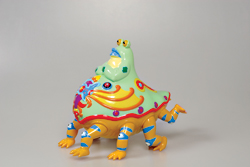With boxes of cartoonish characters stacked high on the shelves, a Belltown boutique is selling über-trendy toys faster than you can say “Beanie Babies.” The difference between Schmancy’s products and the legendary stuffed animals of the ’90s, however, is these figures happen to be painfully cool.
“People are always shocked when I tell them my customer base is 30- to 40-year-old men,” says Schmancy owner Kristin Rask, who is hosting a show of toys created by local artists next week. “It’s fun to be an adult but have this kid side of you, too.”
Said to have begun with customized hip-hop GI Joes at a Japanese toy show in 1997, designer toys have become a must-have in the world of skateboarders and sneaker aficionados, as well as some graffiti and high-end artists. They mostly come in vinyl, sometimes in plush, and their look is often bizarre, ironic, and even disturbing.
Dodge vans with bunny ears, sexy girls with skull maracas, Star Wars flashbacks, and members of the Gorillaz—the designs raise questions about obscenity, mockery, and, ultimately, what “counts” as art.
Although San Francisco and New York are recognized hot beds of designer toy collection, Seattle is home to some of the hottest artists in the scene today.
“I guess Seattle fits into the scene by supporting it and by being so cartoonist-friendly,” says Jim Woodring, a local celebrity cartoonist and toy designer. Woodring works with Maple Leaf comics publisher Fantagraphics Books Inc., which draws a wealth of cartoonists to the area. “There are at least four shops in town that carry an extensive line of toys, and the various books on the subject do well here.”
Most recognized as a comic artist, Woodring has developed about 20 toys. The newest—a grand, multilegged frog with eyes on his knees named Mr. Bumper—will be released through production company STRANGEco this summer. Woodring’s other popular designs include six Imperial Newts; Frank from Woodring’s comic of the same name; and the legendary monster-esque Dorbel, which was STRANGEco’s first vinyl production.
Scott Musgrove, another popular local cartoonist, tapped into the designer toy trend with his Booted Glamour Cat— a beady-eyed, maniacally grinning feline with a spiky fur collar—produced by companies Wootini and STRANGEco. The fad is a boon to artists and collectors, Musgrove says, because “it enables people who are interested in a particular artist to get their work. To get something that’s 20 or 30 dollars is pretty reasonable.”
Typically produced in very small numbers, a certain figure can become highly collectible. Musgrove’s Glamour Cat was produced in various runs of 100 to 600 toys in each of eight colors, selling for a range of $26 to $40. Only 50 figures exist of his special-edition gold version, which sold along with a print for $200.
The business can be very profitable, but it’s not easy for artists to break into. “The thing that sucks is if you want to get your toy out there, you need to come up with about $10,000 to do your first run,” says Schmancy’s Rask. “For a starving artist, that is a huge thing to swallow.”
This is one reason Rask is hosting a show at the Gilt Edge Society on Fourth Avenue on July 14, giving local artists a chance to display customized “platform figures.” These are blank vinyl toys that companies usually ask famous artists to paint and decorate. Munny, the name of the platform toy the artists in Rask’s show will be designing, has a rounded monkey shape with stubby arms and legs. Megacompany Kidrobot created the toy specifically as a do-it-yourself figure. Among the 51 featured artists in “The Munny Show” are locals ParsKid, Jason Sho Green, and Shawn Wolfe.
So, is this a fad, destined to a Beanie Baby fate?
Woodring says he doesn’t care, so long as people connect to the work: “I love the idea of a child chancing upon a battered old, one-armed Dorbel at some future garage sale and being immediately and deeply intrigued. I occasionally hear from people who say they feel intense attraction to, or derive otherworldly pleasure from, say, the Dorbel or the Giant Pupshaw. Needless to say, I think that’s swell. My personal symbolic language doesn’t have meaning for everyone, not by a long shot; but when someone on the same wavelength does feel connected to my work, well, it’s a goddamn love-feast.”






